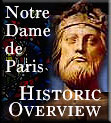

Unique Features of Gothic Churches,
Cathedrals and Monasteries :
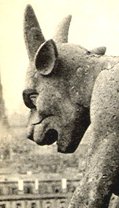 The word refers to sound which water makes as it passes through the gullet. Originally a reference to the drains atop cathedrals which were later carved into the form of beasts or animals.
The word refers to sound which water makes as it passes through the gullet. Originally a reference to the drains atop cathedrals which were later carved into the form of beasts or animals.Image at right : Gargoyle atop Notre Dame, watching over Paris.

Image at right : Detail of a fine Maestà by the Gothic artist Duccio di Buoninsegna; commissioned for the cathedral at Siena in 1308.
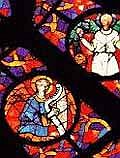 Romanesque period these intricate works of glass, metal and stone literally flowered into holistic representations of the known Universe. While glass windows were used in cathedrals of other countries, the Rose Window was initially a French creation; incorporated initially at St. Denis.
Romanesque period these intricate works of glass, metal and stone literally flowered into holistic representations of the known Universe. While glass windows were used in cathedrals of other countries, the Rose Window was initially a French creation; incorporated initially at St. Denis.Image at right : Detail of Rose window at Rheims cathedral, France.
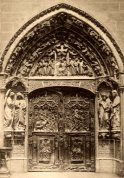
Image at right : Cloister door with tympanum; Burgos cathedral, Spain.
“It is one of the advantages of Gothic architecture,—I use the word Gothic in the most extended sense as broadly opposed to classical,—that it admits of a richness of record altogether unlimited. Its minute and multitudinous sculptural decorations afford means of expressing, either symbolically or literally, all that need be known of national feeling or achievement.
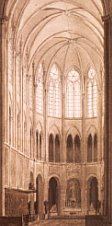 More decoration will, indeed, be usually required than can take so elevated a character; and much, even in the most thoughtful periods, has been left to the freedom of fancy, or suffered to consist of mere repetitions of some national bearing or symbol. It is, however, generally unwise, even in mere surface ornament, to surrender the power and privilege of variety which the spirit of Gothic architecture admits; much more in important features—capitals of columns or bosses, and string-courses, as of course in all confessed bas-reliefs. Better the rudest work that tells a story or records a fact, than the richest without meaning. There should not be a single ornament put upon great civic buildings, without some intellectual intention.”
More decoration will, indeed, be usually required than can take so elevated a character; and much, even in the most thoughtful periods, has been left to the freedom of fancy, or suffered to consist of mere repetitions of some national bearing or symbol. It is, however, generally unwise, even in mere surface ornament, to surrender the power and privilege of variety which the spirit of Gothic architecture admits; much more in important features—capitals of columns or bosses, and string-courses, as of course in all confessed bas-reliefs. Better the rudest work that tells a story or records a fact, than the richest without meaning. There should not be a single ornament put upon great civic buildings, without some intellectual intention.”
“In the woods in a winter afternoon one will see as readily the origin of the stained glass window, with which Gothic cathedrals are adorned, in the colors of the western sky seen through the bare and crossing branches of the forest.”
—Ralph Waldo Emerson
“On entering a church through the porch on the north or south side, or at the west end, we sometimes perceive on the right hand side of the door, at a convenient height from the ground, often beneath a niche, and partly projecting from the wall, a stone basin: this was the stoup, or receptacle for holy water, called also the aspersorium, into which each individual dipped his finger and crossed himself when passing the threshold of the sacred edifice. The custom of aspersion at the church door appears to have been derived from an ancient usage of the heathens, amongst whom, according to Sozomen, the priest was accustomed to sprinkle such as entered into a temple with moist branches of olive.”
—M. H. Bloxam,The Principles of Gothic Ecclesiastical Architecture
“We have endeavoured to restore for the reader this admirable Cathedral of Notre Dame. We have briefly enumerated most of the beauties it possessed in the fifteenth century, though lost to it now; but we have omitted the chief one—the view of Paris as it then appeared from the summits of the towers.
When, after long gropings up the dark perpendicular stair-case which pierces the thick walls of the steeple towers, one emerged at last unexpectedly on to one of the two high platforms inundated with light and air, it was in truth a marvellous picture spread out before you on every side; a spectacle sui generis of which those of our readers can best form an idea who have had the good fortune to see a purely Gothic city, complete and homogeneous, of which there are still a few remaining, such as Nuremberg in Bavaria, Vittoria in Spain, or even smaller specimens, provided they are well-preserved, like Vitré in Brittany and Nordhausen in Prussia.
The Paris of that day, the Paris of the fifteenth century, was already a giant city. We Parisians in general are mistaken as to the amount of ground we imagine we have gained since then. Paris, since the time of Louis XI, has not increased by much more than a third; and, truth to tell, has lost far more in beauty than ever it has gained in size.”
—Victor Hugo,Notre Dame de Paris;
A Bird's-Eye View of Paris
Bibliography
Matthew Holbeche Bloxam, London, D. Bogue (1846)
Eugène Viollet-le-Duc, Paris (1858-68)
Development & Production Credits
Primary Text : Rhey Cedron — Theme Editor : Nicole MarchStructural Design & Project Direction : Rhey Cedron
Art Direction : Rhey Cedron — Art Production : Mark Nelson & Ash' Murti
Artistic Consultant : Thierry Alberto
Art Research : Malcolm Hurrell — Support Research : Walter McCrae
(Life) Support Production : Henry Craig, Joan Flandrin, Clara Kelly and
a Patient Legion of Friends, Family & Angels
cultural projects. Ask to receive your free newsletter
Your questions or comments are always welcome!
Gothic Dreams E-mail
Individual use of enclosed material is encouraged for the purposes of education and enjoyment.
The republication of textual or graphic content, without license, is an infringement of Copyright laws.

